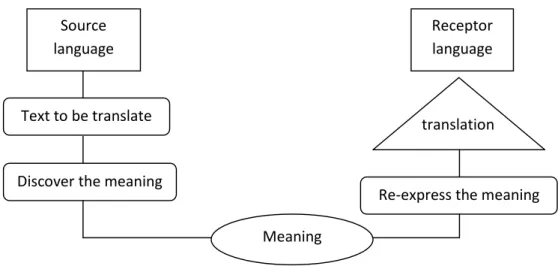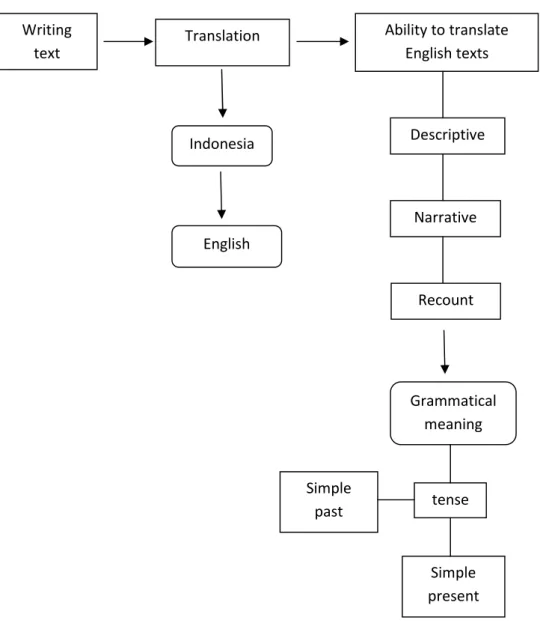Judul Skripsi: The students' ability to translate the Indonesian texts into English (A descriptive research at the second grade of SMA Negeri 2 Pangkep). The students' ability to translate the Indonesian texts into English (A descriptive research at the second grade of SMA Negeri 2 Pangkep). The purpose of this research was to know the students' ability to translate the Indonesian texts into English at the second grade of SMA Negeri 2 Pangkep.
And then, since the percentage of students' ability to translate Indonesian texts into English texts was the lowest in the narrative text category, there was only 50% average score. Therefore, the researcher came to the conclusion that narrative text was the dominant of students' ability which was classified as good categories in the translation of the text, the descriptive text which then also classified as good categories, the narrative text as the low of students s ability that is classified as fair. categories made by the second grade students of SMA Negeri 2 Pangkep. Mustaineh S.Pd as English teacher and all the students of SMP Negeri 2 Pangkep especially for the second grade in academic year 2017/2018 who spared their time and activities to be the subject of this research.
INTRODUCTION
- Research Problems
- Research Objectives
- Significance of the Research
- Scope of the Research
Meanwhile, translation is an activity that increases students' awareness of similarities and differences between the grammatical structure of the source and target languages. Based on the brief explanation above, the researcher is interested in formulating the research title under the title "The Students' Ability to Translate The Indonesian Texts into English at second grade of SMA Negeri 2 Pangkep". To describe the result of students' ability to translate descriptive texts in second grade in SMAN 2 Pangkep.
To describe the result of students' ability to translate narrative texts in second grade in SMAN 2 Pangkep. To describe the result of students' ability to translate retelling texts in second grade in SMAN 2 Pangkep. The scope of this research is limited to analyze students' ability to translate the paragraphs of Indonesian texts into English texts such as descriptive, narrative and retelling text in the second grade of SMAN 2 Pangkep.
REVIEW OF RELATED LITERATURE
Concept of translation
Types of translation
The clearest example of pragmatic translation is the translation of machine repair information. Examples of this type are the translation of a sonnet, a rhyme, a heroic couplet, a dramatic dialogue, and a novel. And the male flies into the sky so that the cubes appear before her eyes.
The purpose of ethnographic translation is to explain the cultural context of the source and target language versions. Translators must be sensitive to the way words are used and must know how the word fits cultures. This concerns the equivalent meanings of the constituent morphemes of the source language and the grammatical form, an example being language in a computer program and machine translation.
Process of translation
The shapes of the text to be translated and the translation results are shown by the different shapes between square and triangle. They describe that in translation text the forms of the source language can be changed to appropriate forms of the receptor language to achieve the idiomatic translation. The distinct meaning of the terms "hammer" and "chair" is very closely marked by the occurrence of these terms in a completely different contrast to verbs.
Connotative meaning refers to how language users respond, either positively or negatively, to words and their combination. On the other hand, there are positive taboos associated with the feeling of fear: certain words (often the names of powerful beings) are also considered powerful, and the misuse of such words can bring destruction to unfortunate users. The first word performs the action of the second word, and the third word identifies the goal of the action specified by the second word.

Good translation
The translation must reflect the style or atmosphere of the original text, because the target is the reader and the translation must therefore be acceptable to the reader. Of the criteria for a good translation, the grammar of the source language plus knowledge of the vocabulary is the most important, as well as a good understanding of the text to be translated. Baker lists five grammar categories that can get a translator into trouble due to the lack of grammatical structure in the target language, namely: number, gender, person, tenses, and voice, but in this study, the researcher focuses only on tenses, such as simple present and simple past.
According to Suherman, the tense defines the form of the verb that represents the time of the event. The function of the simple present is to ask about the usual action, to ask about the general truth, to ask about the ability, to ask about the future state, to use in the imperative and to use in the headline. The function of simple past is to ask about the event in the past moment, and to ask about the usual in the past moment.
Translation evaluation
Acceptability is a target-reader approach where a translation follows the norms of the target language (TL) and culture. It is possible because of the way the spoken text contrasts with the structure, norm and culture of the target text. In English culture, for example, it is common for a grandson to greet his/her grandfather by saying "how are you John".
From this sentence, we could see that the grandson directly mentioned the name of his/her grandfather's child. It is based on the idea that acceptability is directly related to structure, norm and culture in the target language.
English Text
- Descriptive text
- Narrative text
- Recount text
According to Fathoni (2012: 1), there are thirteen types of text in English such as narrative text, narration text, process text, report text, analytical presentation text, orientation presentation text, explanation text, descriptive text, discussion text, news text, review text , anecdotal text and mock text, but in this research, the researcher divides only descriptive text, narrative text and narrative text into three main categories. Descriptive text is one of the few genres in English that students should master in both junior and senior high schools alongside other English texts. According to Setiawan (2014: 1), a descriptive text is a text that focuses more on describing something and usually uses descriptive words.
It means that the descriptive text is a text that says what a person or thing is like. The descriptive text is intended to generally describe and reveal the characteristics of objects, places, or particular creatures without detailed investigation. Identification is the part of the descriptive text that contains the subject or what it aims to describe.
And the description is the last part of descriptive text that contains some of the discussion or the description about the subject, such as the physical, quality and the characteristic of the subject. The purpose of narrative text is to entertain the listener or the reader about the story in the past tense. The story has the connection with the real experiences, imagination or the incidents, and finally finds the solution of the problem in the story. c. Generic structure of narrative text.
One day she overheard her uncle and aunt talking about leaving Snow White in the castle because they both wanted to go to America and didn't have enough money to take Snow White. Doc, one of the dwarves, said, "If you want, you can live here with us." Snow White said, “Oh, I could do it. The purpose of recount text is to entertain or inform the reader without the conflict in the story. c. General structure of the recount text.
In this event, there is usually also the personal commentary about the incident in the story.
Conceptual Framework
First entry; writing the text as an introduction, the researcher will make the test for the students. It consists of three texts (descriptive, narrative and narrative) in Indonesian form in the paper to recognize students' ability in translating Indonesian texts into English texts. The second process; translation skill as a process, the researcher will bring the papers or tests to the school (SMAN 2 Pangkep) and then the researcher will give the tests to the students.
The third exit; ability to translate English texts as output, the researcher will look at the result of the students' test about their ability to translate Indonesian texts into English texts (descriptive, narrative and retelling) towards grammatical meaning, especially about tenses, simple present and simple past.
RESEARCH METHOD
- Variable and Indicator
- Population and Sample
- Research Instrument
- Data Collecting Procedure
- Data Analysis
There used wrong tenses like we, go, so, the researcher gave a score of 3. Descriptive text: correct meaning with minimal omissions, additions and minimal inappropriate words, so the researcher gave a score of 4. Used wrong tenses like EG we, go, must be in the past form, so that the researcher gives point 4.
Use the wrong tenses like we, go, it should be in the past form, so, the researcher has given point 3. Use the wrong tenses, It should be in the past form, so that, the researcher has given point 2. Renumber the text: correct meaning with minimal omissions, additions, minimal inappropriate words and any grammatical errors, so the researcher gave a score of 4.
FINDINGB AND DISCUSSION
Discussions
CONCLUSION AND SUGGESTION
Suggestions
After seeing the findings and the discussion, the researcher offered several suggestions that may be helpful. It is suggested to the English teachers that they should emphasize the translation skills of learning and teaching so that the students can improve their translation skills, especially when translating Indonesian texts into English texts. It is suggested to the students to practice their translation skills, especially when translating Indonesian texts into English texts.
It is suggested to the other researchers that it can be a good reference to research the students' translations from a different point of view. 2011. The effect of form- and meaning-oriented translation instruction on the language proficiency levels of ELT students. Vol, 19 No. 2. 1984. Meaning-Based Translation: A Guide to Equivalence in Multiple Languages. United State of America: University Press of America.
Efektivitas penggunaan teks recounting untuk meningkatkan keterampilan menulis siswa III. kelas SD Kalam Kudus 2 Pematangsiantar. Rubah itu mundur beberapa langkah lagi, berlari dan mencoba meraihnya, namun tetap gagal. Dia mundur beberapa langkah, rubah melompat, tapi sayangnya dia melewatkan anggur yang digantung.
Again the fox took a few steps back, ran and tried to reach them, but he still failed.
